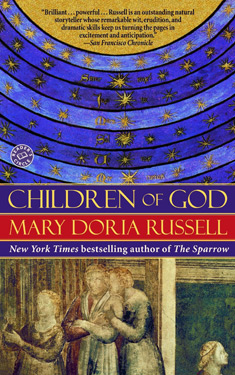Mary Doria Russell
Completed 7/4/2014, Reviewed 7/18/2014
5 stars
“Children of God” is the glorious sequel to one of my
favorite books of all time, “The Sparrow”.
It is one of the few sequels I’ve read that is on par with or perhaps
even better than its predecessor. While
the first book explored deep existential questions with despairing and hopeless
answers, “Children” provides the redemption that often comes when we walk
through fear, either on our own or by being dragged kicking and screaming.
Warning: there are
some spoilers for “The Sparrow” in my review since this is a direct sequel to
it.
Russell picks up the story of Jesuit Father Emilio Sandoz soon
after the trauma of being the only survivor and returnee of humankind’s first mission
to Rakhat, a planet inhabited by intelligent life. He made a breakthrough in dealing with the
horror that the Jana’ata perpetrated on him, but still finds nearly no joy in
life. This begins to change when he
decides to leave the priesthood and finds he might be falling in love with a
woman. But the Jesuits can’t leave Rakhat alone, and want to launch a second
mission. This time, the mission is also
political; the Vatican is involved. The
Pope will back the mission financially and even reconcile its rift with the
Jesuit order on the one condition that Sandoz accompany the new team. The question is how do they get Sandoz to
agree to this, and if he does, will he sink into insanity or find salvation.
The most amazing thing about this book is its nearly seamless
transition from its predecessor. It’s
been nearly a year since I read “The Sparrow”, but I felt like there was no
time lapse at all. “Children” picks up
the story with some summation but it’s not obtrusive in the least. We immediately return to the broken psyche of
Sandoz, and his attempts to have a normal life.
Again, Russell interweaves her locations and timelines. This time it alternates between Sandoz on Earth
and the lone survivor on Rakhat, Sophia, dealing with the two sentient species,
the carnivorous Jana’ata and the Runa, the herbivores who are the Jana’ata’s
servants, concubines, and food source.
Russell fully fleshes out the world she had already created, bringing us
deeper into the societies of the two species, and the seemingly insurmountable
problem of normalizing a civilization after its core belief and organization is completely
dismantled.
The narration is no longer just from the human point of
view. It is now also told from the point
of view of the Runa and Jana’ata. Through
these characters, we learn more about the politics and social structure of the
two species since the arrival of the first Jesuit mission. One of these voices is Supaari VaGayjur, a
Jana’ata merchant we met in the first book, whose life and livelihood has been
destroyed. He is in exile with his
daughter Ha’anala. Eventually, he finds
Sophia, now with her own child, Isaac.
Together they continue the legacy of the act of defiance of the Runa
that is turning the whole planet upside-down.
In an interesting sub-plot, Sophia’s son Isaac is
autistic. Russell did a lot of research
on autism to create this character, including reading the works of Temple
Grandin, who I’ve also read and admire.
She did a fantastic job of portraying the difficulty of a mother trying
to relate to her autistic child. As his
name implies from the Biblical reference, he becomes a sort of patriarch of a
new community where both the Runa and Jana’ata live together in peace. Though more of a cryptic ascetic than one
normally might assume from the name of one of the fathers of Jewish people, he
becomes the force that helps build the new society out of the rubble of the
old.
Like the first book, “Children of God” moved me
profoundly. I found myself inside many
of the characters heads, feeling the abandonment, fear, and eventual redemption
in their journeys. I wished the book
didn’t end, but rejoiced in the resolution.
Mary Doria Russell has written two of the greatest books I’ve come
across in the 100+ I’ve read in the past two to three years. Five stars out of five.

No comments:
Post a Comment